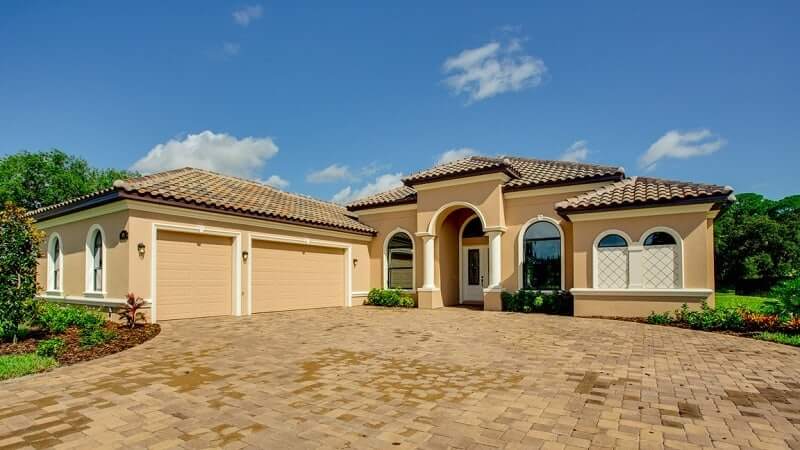
HOME BUILDING PROCESS EXPLAINED IN EASY STEPS:
Constructing own home is very cost effective and quality of construction is also good. But many people spend more than the budgets to build their homes. The real problem is that they have no experience or knowledge about house construction. With the basic information about home building process you can save a lot of money. Here is the outline of “Home Building Process” article;
Building own home
House construction planning
Finding the right architect and builder
Vetting the architect and builder
Top 3 home building options
Home construction contract
House construction cost details
Home building cost by percentage of work
6 tips for building home to a budget
15 simple steps to construct a house
BUILDING OWN HOME:
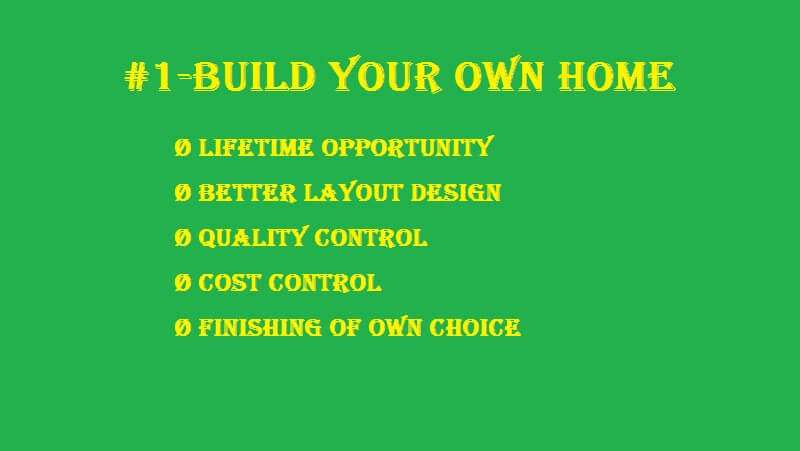
Homes are where we spend most of our lives. Ideally homes should have beautiful designs with high quality of construction. To own a home people have different opinions but all agree that it’s a unique experience to build personal home. Actually there are many benefits of building own home. Firstly it’s a great excitement to build own home. Secondly you can design your home according to your requirements and lifestyle. Thirdly it’s easy to control the construction quality. Many people who buy homes constructed by the builders always complain about the quality of construction. Fourthly by building home you can select the finishes and color schemes of your choice. Fifthly many people do alterations when they buy homes. But you don’t need to spend on the renovations as you build your home according to your requirements and choice. If you are ready to build your dream home then keep reading “Home Building Process” article.
HOUSE CONSTRUCTION PLANNING:
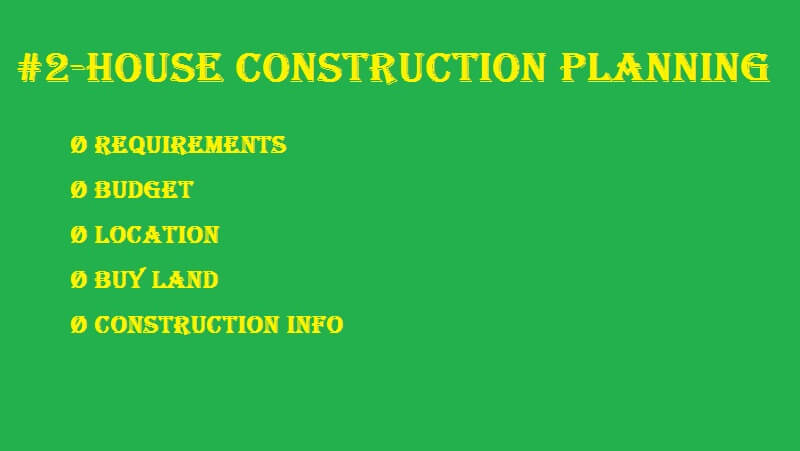
The first step of home building process is the planning. The construction planning includes the following steps;
Consider your requirements
Different people have different requirements depending on their circumstances. Some people want 2-3 bedroom homes whereas others need 5-6 bedroom homes. Similarly many people need extra features like store room, separate living & drawing rooms, garden and two kitchens. For home construction you should carefully review your requirements as these will impact the home design and construction cost.
Prepare your budget
Budget planning is very important for building a home as it has huge impact on the home size and quality of construction. With a big budget you can construct a large size home that has top quality finishes. On the other hand with a limited budget you can construct a home of average size and quality. It’s highly recommended to stay within your budget otherwise you will accumulate the debts.
Select a location
Building a home is more than living as it’s also a very profitable investment. While building a home you should also consider the resale value. A prime location home sells easily whereas it’s hard to find buyers for a bad location home. To choose a good location you should consider the areas that are near to top schools, hospitals, parks, commercial centers, business areas and transportation links.
Buy the land
The next step is to purchase the land for home construction. Plot should be big enough to build a home that has the natural light and ventilation. The land should be located on a wide road. Prefer to select the South facing land that is ideal to install the solar panels due to the greater exposure to sun. If your budget allows then prefer to buy a corner plot as it will provide many benefits like extra parking on side road and two entrances.
Educate yourself about home building process
Once you have bought the land to build a home, it’s the right time to know about home building process. You can acquire the information from your friends and family members who have recently built their homes. The other way is to visit the under construction homes in your neighborhood. You should ask about their experience of home construction. It’s also good idea to know the difficulties and technical issues involved in home building.
FINDING THE RIGHT ARCHITECT AND BUILDER:
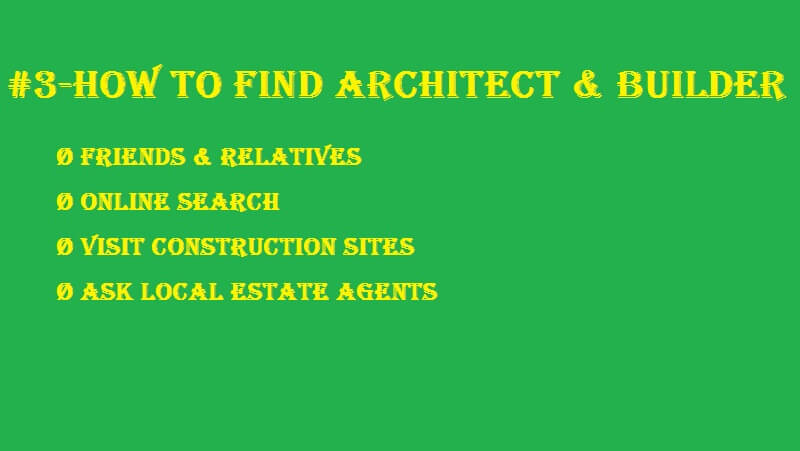
Finding the architect & builder is very important to construct a home that has beautiful design and sound structure. A home designed by the top architect has good resale value due to beautiful layout, elegant interiors and marvelous elevations. Whereas a home built by top builder has high construction quality and long life. Just keep in mind that houses designed by good architects and constructed by top builders have high resale values. Here are the top 3 ways to find good architects and builders.
Way #1:
The first way to find good architect and builder is to ask your relatives and friends who have recently constructed their homes. Discuss with them about the behaviors and works of architects & builders and select the best ones.
Way #2:
Visit the under construction houses in the area where you want to build your own home. Check the home layout and construction quality. If you are satisfied then meet the home owner to know about the architect and builder.
Way #3:
Now a days architects and builders have their websites and social media pages. Just google the top architects and builders in your city. Check their profiles and contact them once you are satisfied by their past works.
VETTING THE ARCHITECT AND BUILDER:
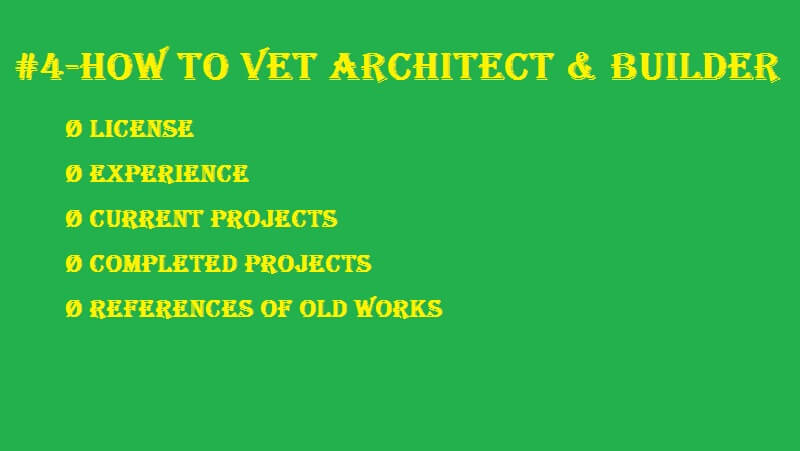
Construction industry can be divided into two sectors, residential and non-residential. Many architects and builders are very famous but have little experience of residential projects. You have to select the architect and builder who have vast experience in residential projects. This will save you lot of money and your house will be of top quality. Here are the top 5 questions you should ask to vet architect and builder.
Question #1:
The trade license
Question #2:
The relevant experience
Question #3:
The ongoing projects
Question #4:
The completed works
Question #5:
The references of the past clients
TOP 3 HOME BUILDING OPTIONS:
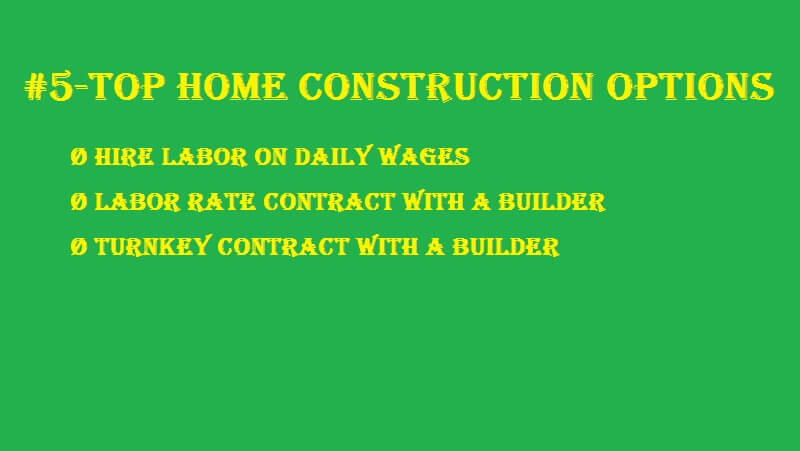
Many people know the construction work and prefer to build own homes. If you are one of them then you should construct your own home. Otherwise you have the three options; directly hire the labor, hire a builder on labor rate or sign construction contract with a builder on turn key basis. Here are the advantages and disadvantages of top three home construction options;
Option #1: Constructing home by hiring daily wage labor
The first way to construct your home is to hire the labor on daily wages. This is the oldest method to build a home. The advantage of this option is that you can build your home in stages according to your financial situation. The disadvantage of this option is that labor works very slowly as they want to linger on the work. Therefore progress of the work will be slow but labor cost will be high.
Option #2: Constructing home by hiring a builder on labor rate
The second way to construct your home is to sign the contract with a builder on labor rate. In a labor rate contract, you will provide the materials whereas builder will bring in his team to construct the home. Builder will charge you according to labor rate decided in the contract. The advantages of this option are that you can control the quality of materials and it’s also very cost effective. The disadvantage of this option is that you have to regularly check the quality of construction as builder will try to complete the work in a hurry to maximize his profit.
Option #3: Constructing home by hiring a builder on turnkey basis
The third way to construct your home is to hire a builder on turnkey basis. In a turnkey contract, you will just pay the money whereas builder will buy the materials and bring in his team to construct your home. The advantage of this option is that you are free from all responsibilities as it’s the duty of the builder to construct home on time. The disadvantage of this option is that it’s hard to control the quality of construction and materials as builder can use substandard materials to maximize the profit.
HOME CONSTRUCTION CONTRACT:
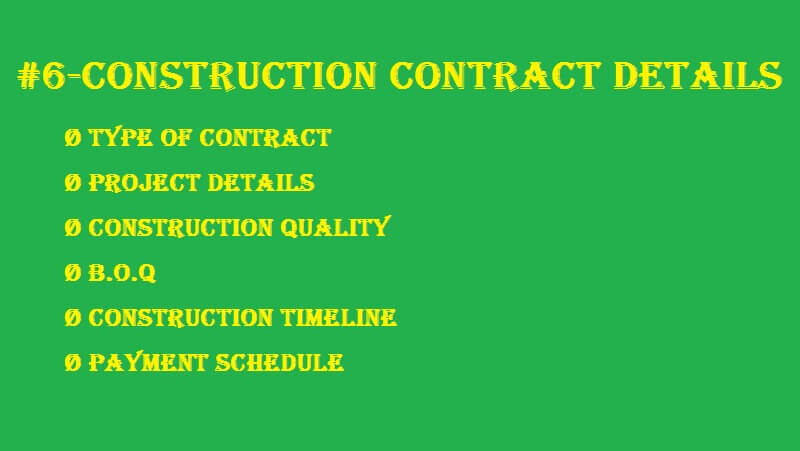
Most people hire a builder to construct their homes. If you want the same then you have to sign a construction contract with a builder. The contract specifies the duties and rights of both owner and builder. It’s important to keep a copy of the contract as you will need it if any dispute arises. Here are the specifications of a construction contract.
Type of Construction Contract
Project Briefing
General Terms & Conditions
Architectural and structural Drawings
Construction Estimate or Bill of Quantities; B.O.Q
Material Specifications
Quality of Finishes
Class of Construction
Mode of Payment
Construction Timeline
HOUSE CONSTRUCTION COST DETAILS:
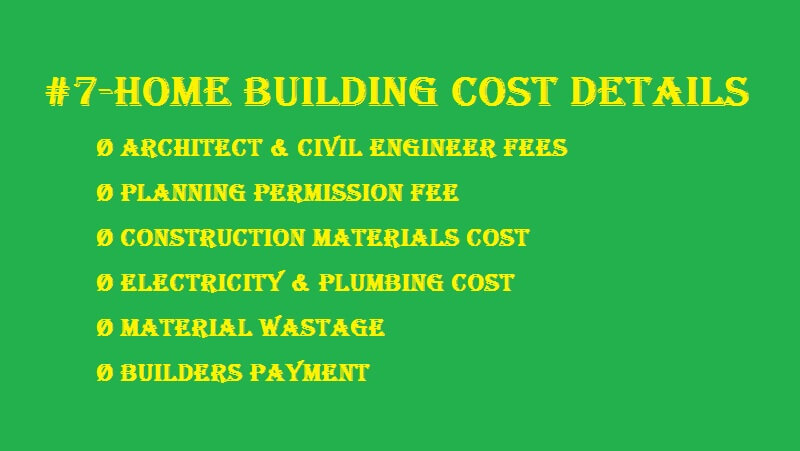
Followings are the fees or costs paid by the owner to construct a home;
Architect’s Fee
The first cost you have to pay for constructing your home is the fee of the architect. Different architects have different fees depending on the scale of the work. Architect will charge you less if you just want the architectural drawings, but will charge you more if you also want the site supervision services. Normally architects charge 5-10% of the total construction cost.
Structural Engineer’s Fee
Most architects provide the structural drawings as their teams also include the structural engineers. But in case your architect just provides the architectural drawings then you need to hire a structural engineer to design the structure and prepare the B.O.Q. Normally for the residential projects, structural engineers charge 1-5% of the construction cost.
Planning Permission Fee
To construct your home you have to pay the charges to the local development authority. The development authority charges firstly for the utilities it will provide and secondly for the construction of home. Different development authorities have different charges that are up to 5% of the overall construction cost. The local development authority will not pass your map or layout plan unless you pay their dues.
Building Materials Costs
Building materials can be divided into two types, structural materials and finishing materials. Structural materials include the bricks, cement, sand, aggregate, steel, etc. The finishing materials include the tiles, marble, wood, plastic, paints, etc. About 75% of the total construction budget is spent to buy the building materials.
Payments to the Builder
Builder’s payment depends on the type of construction contract. If you have hired the builder on labor rate then builder’s payment will be approximately 10% of the construction cost as he will only charge for his services. On the other hand if you have hired the builder on turnkey basis then builder’s payment will be approximately 85% of the construction cost as he will also buy the construction materials. Also note that builders are paid in stages depending on the completion of the construction work.
Other Expenses
Building a home has some hidden charges. Firstly you have to pay for the installation of utility services like electricity, gas and water. Secondly you have to hire a watchman who will take care and keep the construction equipment & materials. Thirdly lot of material is wasted during construction. According to the construction experts the cost of the waste martial is up to 5% of the total construction cost.
HOME BUILDING COST BY PERCENTAGE OF WORK:
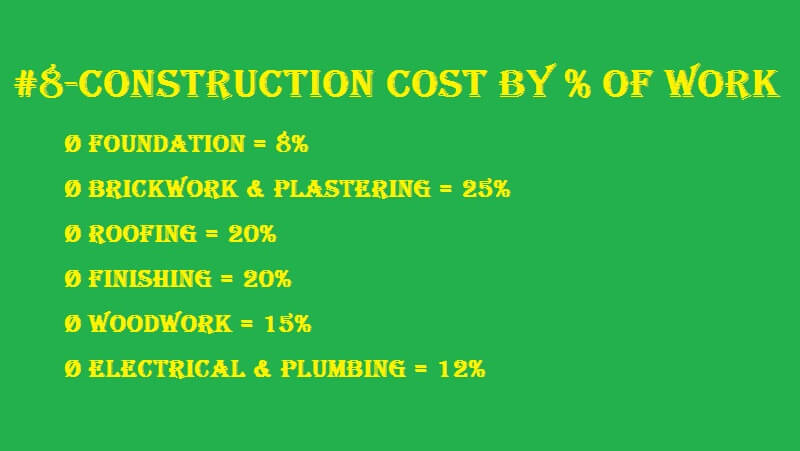
The civil engineers have calculated the percentage of construction cost depending on work type. Here is the detail of it;
Foundation Cost = 8%
Brickwork / Walls Cost = 25%
Roofing Cost = 20%
Finishing Cost = 20%
Woodwork Cost = 15%
Electrical & Plumbing Cost = 12%
Total Cost = 100%
6 TIPS FOR BUILDING HOME TO A BUDGET:
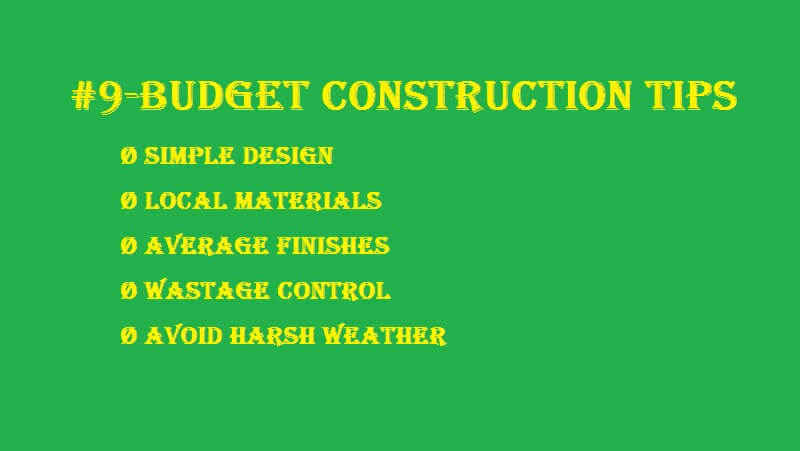
Here are the top 6 tips for building a budget home;
Select a simple design
Modern houses with straight line elevations and simple features cost less to build. Whereas, traditional house designs with arches and domes cost more to build, as labor cost and material wastage increases. You should ask your architect to design simple and modern house as they cost less to build. Modern homes also sell like hot cakes, as most people like modern homes than traditional ones.
Buy building materials from local suppliers
Transportation cost is a major factor in the overall cost of home construction. Building materials supplied from remote areas cost more as transportation cost increases. Therefore to build a home on budget, you should select the local building material suppliers as they will transport the construction materials on normal rates.
Choose normal finishing
Quality of finishes you choose for your home also matters. Home finishes have lot of price variation. You can choose normal finishes than luxury or very expensive finishes. Expensive finishes and fixtures will increase the cost of construction. This is recommended that you just buy the average price finishes for your home.
Buy home finishes after market research
Cost of finishing material has lot of variation due to the large margins. Many sellers sell their products on high rate, whereas others sell on normal rates. Therefore finishing materials like fixtures, marble, tiles, door handles and switches should be bought after thorough market research to build your home on budget.
Control the material wastage
Normally lot of building and finishing material is wasted by the labor during construction of a home. This wastage is normally due to the careless handling of construction material on the site. This wastage of construction material increases the overall construction cost of home. Normally 10% material is wasted on site which is known as damage cost. This damage cost can be controlled by encouraging the labor to carefully handle the materials.
Never start construction work in rainy season
You should avoid staring the construction work in rainy seasons. Many hazards have been recorded during the rainy seasons like collapse of walls as foundations never gain full strength. Pace of construction work is also affected as you cannot plaster outer walls due to rain. Construction materials also cost more in rainy season due to transportation issues. So never start home construction in the rainy season as it increases the construction cost.
15 SIMPLE STEPS TO CONSTRUCT A HOME:

Here are the 15 easy steps to build your home or Home Building Process;
Step #1: Preparation of the site for construction work
Step #2: Excavation and construction of foundations
Step #3: Construction of ground floor walls
Step #4: Construction of ground floor roof
Step #5: Construction of first floor walls
Step #6: Construction of first floor roof
Step #7: Plastering of ceilings and walls
Step #8: Electrical and plumbing works
Step #9: Preparation of floors
Step #10: Installation of tiles and marbles
Step #11: Installation of fixtures
Step #12: Installation of doors
Step #13: Installation of windows
Step #14: Interiors and exteriors painting
Step #15: Woodwork completion
